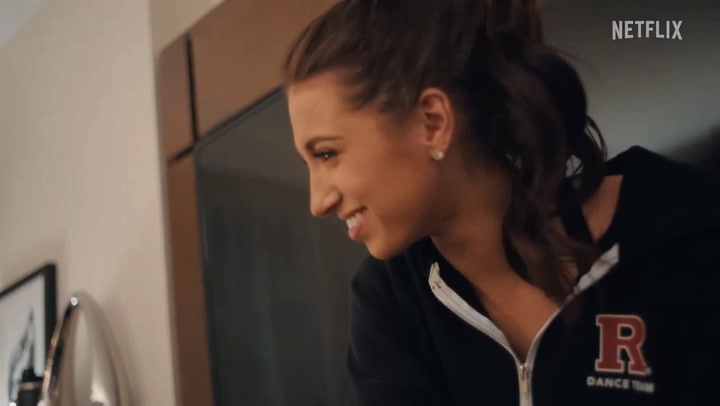In a world where entertainment increasingly shapes cultural norms, values, and self-perception, the power of media can never be underestimated—especially when it comes to impressionable young viewers. Netflix’s America’s Sweethearts, a glossy, addictive, and high-drama docuseries centered on the glamorous lives of the Dallas Cowboys Cheerleaders, is quickly becoming a cultural phenomenon. But beneath the sequins, sisterhood, and sparkle lies a more troubling reality: the show, while entertaining, may be setting a problematic precedent for how young girls view success, self-worth, and womanhood.
At face value, America’s Sweethearts is a celebration of dedication, athleticism, and ambition. The series follows the world-famous Dallas Cowboys Cheerleaders (DCC) as they undergo intense auditions, grueling rehearsals, and the emotional highs and lows of being part of one of the most iconic cheerleading squads in the world. The visuals are stunning, the stories compelling, and the choreography breathtaking. But beyond the surface, there’s an underlying message that success for women must come hand-in-hand with beauty, perfection, and compliance to outdated ideals.
The show’s overwhelming focus on physical appearance sets a concerning tone from the outset. While it’s undeniable that the DCC is built around performance and aesthetic appeal, America’s Sweethearts turns this focus into a measuring stick for personal worth. Close-up shots of women being scrutinized for their weight, makeup, and outfit choices create a toxic environment under the guise of excellence. The rigid standards portrayed not only reinforce narrow beauty ideals but also contribute to the ongoing mental health crisis among young girls who are constantly bombarded with images of “perfection” they feel pressured to emulate.
Furthermore, the series romanticizes a system where young women are expected to sacrifice their individuality for a tightly controlled brand. Many of the cheerleaders talk openly about the stress of maintaining a particular image, the fear of being cut for gaining a few pounds, and the pressure to stay upbeat and “on” at all times. Their lives are shaped by external expectations that rarely allow room for authenticity, vulnerability, or deviation. In doing so, the show subtly suggests that conforming to these impossible standards is not only admirable—it’s necessary for success and belonging.
This is especially damaging when we consider who is watching. Teenage girls and young women, the demographic most likely to consume this type of content, are at a formative stage in developing their sense of identity. For them, America’s Sweethearts presents a misleading equation: beauty plus obedience equals worthiness. It downplays the value of intelligence, creativity, leadership, and diversity—qualities that should be championed but are instead sidelined in favor of body measurements and photo-ready smiles.
In addition to reinforcing unrealistic beauty standards, the show fails to adequately question the institutional structures behind the DCC. The cheerleaders work demanding hours, rehearse late into the night, and are expected to present a flawless front at all times. Yet, compensation and autonomy appear limited. While some moments of critique surface—mentions of exhaustion, injuries, or internal politics—they are quickly glossed over in favor of triumphant music montages and emotional team bonding. This glossing over sends a subtle but clear message: endure the hardship, don’t question authority, and above all, smile through it. For a generation of young viewers being taught to stand up for themselves and question unfair power dynamics, this is a dangerous contradiction.
Moreover, the show paints a picture where femininity is tightly boxed into outdated norms. Hair must be curled just right, makeup must be flawless, and bodies must be “tight” yet still “feminine.” There’s little room for variance or rebellion. Any step outside the narrowly defined boundaries is met with corrective measures, whether from coaches, choreographers, or peers. This rigid vision of what it means to be a woman—beautiful, deferential, supportive, and silent—feels more 1950s than 2020s.
Some may argue that America’s Sweethearts is simply documenting reality, not endorsing it. But in a media environment where representation matters more than ever, presentation cannot be divorced from implication. When the camera lingers on weigh-ins more than intellectual conversations, when emotional vulnerability is treated as weakness, and when the spotlight favors those who best embody traditional ideals, the message is implicit: this is the kind of woman who wins.
To its credit, the show does highlight the athleticism and resilience of its stars. The cheerleaders are not passive beauties; they are dancers, athletes, and performers who work tirelessly to master their craft. Their commitment is inspiring. Their bond is real. And their stories—of overcoming injury, self-doubt, and external criticism—are deeply human. But even these admirable qualities are often overshadowed by the relentless focus on physical image. Rather than exploring their ambitions beyond cheerleading, their personal philosophies, or their broader contributions to society, the show reduces most narratives to a familiar formula: pretty girl fights to stay pretty enough to make the cut.
This reductive portrayal misses a huge opportunity. There’s a hunger among young audiences for more nuanced, empowering content. Shows that celebrate the complexity of womanhood—the messiness, the contradictions, the triumphs and setbacks—are not only more truthful, they’re more meaningful. Viewers deserve to see women who are allowed to be more than just beautiful. They deserve role models who don’t have to fit into a mold to be celebrated.
In a time when social media already bombards girls with filtered perfection, a show like America’s Sweethearts should aim to be a counterbalance, not a reinforcement. Instead, it becomes yet another mirror held up to young women, asking them to scrutinize themselves through someone else’s lens. The dangers of this are not hypothetical. Study after study links media consumption to issues like low self-esteem, eating disorders, and anxiety among girls. By normalizing extreme body expectations and rigid gender roles, the show inadvertently feeds these existing challenges.
What’s especially disheartening is how America’s Sweethearts cloaks these messages in the language of empowerment. Viewers are told this is about “dreams coming true,” about “being part of something bigger,” and about “girl power.” But real empowerment isn’t about fitting into someone else’s vision of perfection. It’s about being free to define your own path, to take up space in ways that feel authentic, and to know your worth isn’t tied to your waistline, your lipstick, or your ability to smile through pain.
There’s a reason why so many young women connect with characters and stories that break the mold—whether it’s a flawed female protagonist in a gritty drama, a rebellious heroine in a YA novel, or a real-life athlete who refuses to conform to sexist expectations. These figures resonate because they feel real. They show that strength comes in many forms—and that it’s okay to be bold, messy, outspoken, and different.
America’s Sweethearts had the chance to be one of those shows. It could have gone deeper. It could have asked harder questions. It could have exposed the contradictions and pushed for a more inclusive, honest look at what it means to be a modern woman in the spotlight. Instead, it chose glitter over grit.
That doesn’t mean the show should be banned or boycotted. It simply means we must approach it with a critical eye—and teach younger viewers to do the same. We must challenge the idea that being chosen, being seen, or being praised always equates to being valued. And we must remind girls that they don’t need to earn love or success by shrinking themselves—physically, emotionally, or spiritually.
In the end, America’s Sweethearts is not just a show about cheerleaders. It’s a reflection of the stories we still tell about women. It reveals how far we’ve come—and how much further we have to go. If we want to raise a generation of girls who are strong, free-thinking, and self-assured, we need to offer them narratives that uplift all parts of who they are—not just the ones that look good under stadium lights.



